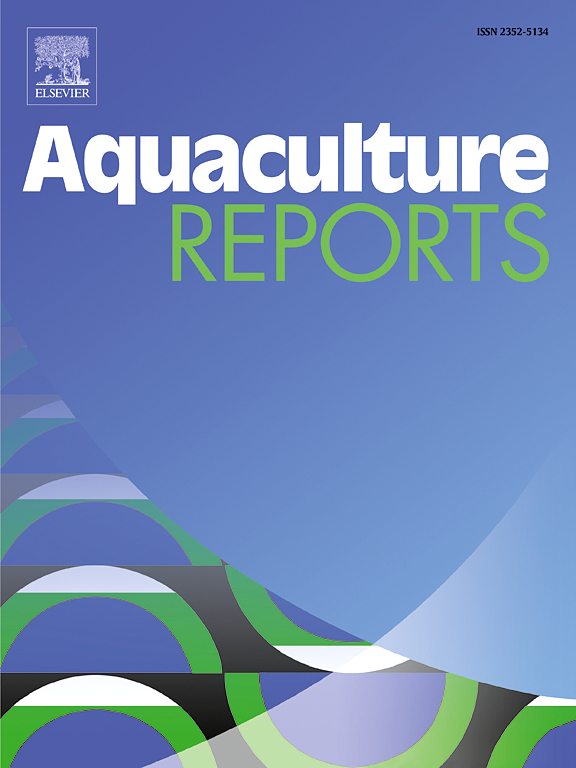增强尼罗罗非鱼疾病检测的自适应人工多智能融合系统 (A-AMIFS)
IF 3.7
2区 农林科学
Q1 FISHERIES
引用次数: 0
摘要
由于疾病爆发会对经济和粮食安全造成重大影响,因此开发高效的尼罗罗非鱼疾病检测系统至关重要。传统的疾病识别方法耗费大量人力,效率低下,而且往往无法检测到疾病的早期症状,从而导致巨大的经济损失。本研究介绍了自适应人工多元智能融合系统(A-AMIFS),这是一种先进的模型,创新性地结合了图像增强、集合图像分割方法和集合卷积神经网络(CNN)架构。该系统利用非群体人工多元智能系统(np-AMIS)优化图像增强,利用群体人工多元智能系统(Pop-AMIS)进行决策融合,表现出卓越的性能。该系统在尼罗罗非鱼病-1(NTD-1)和尼罗罗非鱼病-2(NTD-2)两个新数据集上进行了评估,总体准确率达到 98.26%,精确率达到 98.35%,召回率达到 98.30%,F1 分数达到 98.32%,明显优于现有方法。此外,该系统还开发了 "聊天机器人 "功能,使养殖户能够使用集合模型作为后台分类系统自动检测鱼病,分类准确率超过 98%,令人印象深刻。这些结果凸显了该系统在检测尼罗罗非鱼各种疾病方面的鲁棒性,以及其改变水产养殖中疾病检测的潜力。所提出的系统减少了人工劳动,优化了疾病识别过程,加强了疾病管理策略,促进了水产养殖业的可持续发展和高产。这项研究强调了人工智能技术在克服水产养殖中疾病检测和管理的复杂挑战方面所发挥的不可或缺的作用,提出了高效和有效的疾病管理方法。通过利用先进的图像增强、集合分割方法和集合 CNN 架构,本研究提出了一种革命性的尼罗罗非鱼疾病检测方法。用户友好型聊天机器人界面的整合进一步增强了该技术的可访问性和实际应用性,使农民能够积极主动地管理疾病爆发并减少经济损失。本文章由计算机程序翻译,如有差异,请以英文原文为准。
Adaptive artificial multiple intelligence fusion system (A-AMIFS) for enhanced disease detection in Nile Tilapia
The development of an efficient disease detection system for Nile Tilapia is critical due to the significant economic and food security impacts of disease outbreaks. Traditional disease identification methods are labor-intensive, inefficient, and often fail to detect early signs of disease, leading to substantial economic losses. This study introduces the Adaptive Artificial Multiple Intelligence Fusion System (A-AMIFS), an advanced model that innovatively combines image augmentation, ensemble image segmentation methods, and ensemble Convolutional Neural Network (CNN) architectures. The system utilizes a non-population-based artificial multiple intelligence system (np-AMIS) for optimizing image augmentation and a population-based system (Pop-AMIS) for decision fusion, demonstrating superior performance. Evaluated on two novel datasets, Nile Tilapia Disease-1 (NTD-1) and Nile Tilapia Disease-2 (NTD-2), the system achieved an overall accuracy of 98.26 %, precision of 98.35 %, recall of 98.30 %, and an F1-score of 98.32 %, significantly outperforming existing methodologies. Additionally, a "chatbot" feature was developed to enable farmers to automatically detect fish diseases using the ensemble model as the backend classification system, achieving an impressive classification accuracy of over 98 %. These results underscore the system's robustness in detecting various diseases in Nile Tilapia and its potential to transform disease detection in aquaculture. The proposed system reduces manual labor, optimizes disease identification processes, and enhances disease management strategies, promoting more sustainable and productive aquaculture practices. This research highlights the indispensable role of AI techniques in overcoming the complex challenges of disease detection and management in aquaculture, presenting efficient and effective disease management practices. By leveraging advanced image augmentation, ensemble segmentation methods, and ensemble CNN architectures, this study presents a revolutionary approach to disease detection in Nile Tilapia. The integration of a user-friendly chatbot interface further enhances the technology's accessibility and practical application, empowering farmers to proactively manage disease outbreaks and mitigate economic losses.
求助全文
通过发布文献求助,成功后即可免费获取论文全文。
去求助
来源期刊

Aquaculture Reports
Agricultural and Biological Sciences-Animal Science and Zoology
CiteScore
5.90
自引率
8.10%
发文量
469
审稿时长
77 days
期刊介绍:
Aquaculture Reports will publish original research papers and reviews documenting outstanding science with a regional context and focus, answering the need for high quality information on novel species, systems and regions in emerging areas of aquaculture research and development, such as integrated multi-trophic aquaculture, urban aquaculture, ornamental, unfed aquaculture, offshore aquaculture and others. Papers having industry research as priority and encompassing product development research or current industry practice are encouraged.
 求助内容:
求助内容: 应助结果提醒方式:
应助结果提醒方式:


